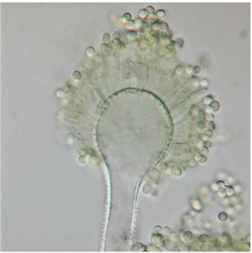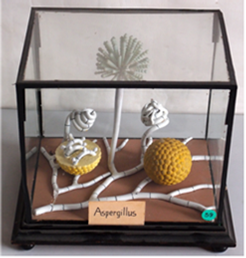In our previous
article, we discussed mycotoxins and their impact of food safety. In this article, we will zoom in to look at aflatoxins, which are a type of mycotoxin, how they impact our health and how to reduce aflatoxins in our food.
What are aflatoxins?
Aflatoxins are a type of mycotoxin that can be poisonous. They are produced by some types of moulds (Aspergillus flavus, Aspergillus parasiticus, Aspergillus nomius) that grow in soil, decaying vegetation, hay, and grains. These moulds are prevalent in tropical regions where temperatures and humidity are high.
Aflatoxins can contaminate crops before and after harvest. Some examples of food that are frequently affected include cereals, maize, rice, corn, figs, nuts, oilseeds, and other oil products.
The four main groups of aflatoxins that are of significant health concern to humans are aflatoxins G2, G1, B2, B1. Unlike the moulds that produce them, aflatoxins cannot be easily identified because they are odourless, tasteless and colourless.
Once produced, aflatoxins are chemically stable in food and cannot be easily eliminated from food – even at high temperatures encountered in food processing, such as roasting, baking, and even frying.
In addition to these, aflatoxins M1 and M2 can also contaminate milk. This can happen when livestock consume feed contaminated with aflatoxins.
What are the health impacts associated with aflatoxins?
Aflatoxins have shown to be genotoxic carcinogens, which means that they can damage DNA and cause cancer in both humans and animals.
In particular, aflatoxin B1 is regarded as a Class 1 carcinogen by the World Health Organization (WHO). This means that there is enough evidence to conclude definitively that it will cause cancer in humans when consumed over extended periods of time.
It is the most potent genotoxic carcinogen, followed by Aflatoxins G1, B2, and G2. Aflatoxins M1 and M2 are also carcinogenic, though less potent than Aflatoxins B1 and B2.
Low dosage levels of aflatoxins over extended periods of time can lead to chronic aflatoxicosis. This can potentially lead to liver cancer, immunosuppression, as well as impaired growth and birth defects in children.
On the other hand, high dosage levels of aflatoxins over a short period can lead to acute aflatoxicosis, which can potentially result if foods containing > 1 mg/kg of aflatoxins are consumed. This can lead to vomiting, damage to the liver, haemorrhage of internal organs and even death.
However, acute aflatoxicosis is rarely encountered. Chronic aflatoxicosis is of a greater concern because aflatoxins are widespread in low levels in the environment.
What is SFA doing to control the levels of aflatoxins in food?
SFA has place a science and risk-based food safety system to address the risks that mycotoxins pose to human and animal health.
Firstly, SFA conducts risk assessment on mycotoxins. During this process, SFA considers the risk assessments done by international organisations such as the Joint FAO/WHO Expert Committee on Food Additives (JECFA).
Secondly, SFA sets maximum limits for mycotoxins in food to protect public health. SFA takes into consideration the limits established by the Codex Alimentarius Commission* (CAC) and has set maximum levels for total aflatoxins, aflatoxins B1 and aflatoxins M1 as low as reasonably achievable.
Thirdly, to ensure compliance to these requirements, SFA samples and tests food products sold in Singapore for mycotoxins. So far, the levels of aflatoxins are detected in our food is not of a significant concern. Food that is not compliant with SFA’s food safety standards will not be allowed for sale in Singapore.
*The CAC is an intergovernmental standards-setting body for food which recommends maximum levels in food to manage food safety risks while facilitating trade between countries.
What can the industry do to reduce aflatoxins found in food?
Contamination of crops by aflatoxin-producing mould can occur at all stages of the crop cycle, including growth in the field, during harvest, transport and storage. The industry is therefore advised on the following:
- Manage transportation and storage conditions such as temperature, water activity, aeration and storage time to discourage mould growth and aflatoxin production in crops.
- Adopt chemical methods, such as treatment with organic acids, ammonia, ozone or enzymes, to minimize the levels of aflatoxins present in food and feed.
- Obtain raw materials from reliable and reputable suppliers for food processing and preparation.
- Adopt Good Manufacturing Practices (GMP) and/or Hazard Analysis Critical Control Point (HACCP) programs.
What steps can consumers take to reduce our exposure to aflatoxins?
Since moulds are ubiquitous in nature, it may not be possible to completely remove aflatoxins from our food through washing and cooking. As consumers, we can practice the following to reduce our exposure:
- Check and ensure that food is free of mould before purchase or consumption, and discard any food that look mouldy, damped, discoloured or shrivelled.
- Do not purchase food stored in unclean, opened or damaged packaging.
- Store food in dry (humidity < 80%), cool (temperature < 20 ⁰C) and insect-free conditions to prevent the formation of aflatoxin-producing moulds.
- Avoid exposing food to direct sunlight.
- Do not consume food that have passed the expiration date.
- Where expiry date markings are not indicated (such as for some non-packaged food), purchase and consume such food that are as fresh as possible.
- Avoid the consumption of damaged grains as they are more prone to the invasion of moulds and therefore mycotoxin contamination.
- Ensure a diverse diet to help reduce one’s exposure to mycotoxins.


(Left) Microscopic image of Aspergillus flavus (Credit: Medmyco/ CC-BY-SA-3.0) and (Right) Models of Aspergillus spp. (Credit: David Ludwig/ CC-BY-SA-3.0) from the collection of the Botanical Museum in Greifswald, Germany. Images reproduced from Wikipedia under Creative Commons licence.